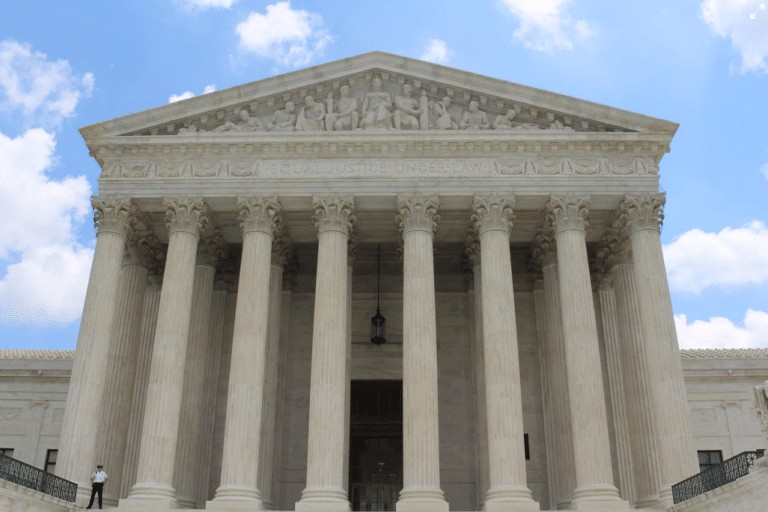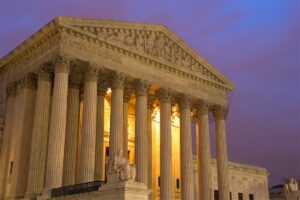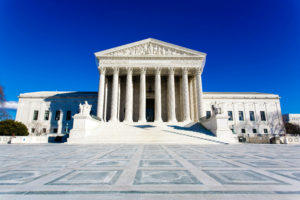American Bar Association: The least dangerous branch of government

This article originally appeared in the American Bar Association’s Supreme Court Preview.
The Supreme Court’s October Term 2023 likely will be remembered in history books as a turning point for the constitutional separation of powers. Rulings in Loper Bright v. Raimondo, Corner Post v. Board of Governors of the Federal Reserve System, and SEC v. Jarkesy will work in concert to limit the power of the administrative state. Critics have proclaimed loudly that the Supreme Court grabbed power for itself this term, stripping agencies of tools to keep our “air and water clean, food and drugs safe, and financial markets honest[,]” as one dissent put it. But any power the Court grabbed this term was simply the power to say, “No.” Alexander Hamilton wrote in Federalist 78 that the judiciary would be the “least dangerous branch” because it is inherently reactive. Unlike the executive, the judiciary does not wield “the sword of the community[,]” and unlike Congress, it does not control the power of the purse or the power to set rules regulating society. The judiciary is “least in a capacity to annoy or injure[.]” After decades of agencies accumulating power—often at Congress’s behest and with the Supreme Court’s blessing—the Supreme Court is reining in agencies. While the Supreme Court remains the least dangerous branch, after this term, it ensured agencies are a little less dangerous too.
Loper Bright Enterprises v. Raimondo and Relentless, Inc v. Department of Commerce
This case concerns a doctrine known as Chevron deference that was once championed by conservatives as a way to minimize policymaking by judges. This doctrine required courts to defer to agencies’ reasonable interpretations of vague laws. Over time, however, agencies pressed interpretations of laws that expanded their power beyond what Congress authorized. In recent years, the Supreme Court has been increasingly skeptical of Chevron deference, particularly since it empowered agencies to change their interpretations of laws based on who was in the White House. Loper Bright and Relentless offered the Supreme Court an opportunity to eliminate Chevron deference.
The Magnuson-Stevens Act is a federal law dealing with fishery management in federal waters. Congress authorizes the National Marine Fisheries Service to require fishing vessels to carry federal observers onboard to ensure compliance with various regulations. After funds Congress appropriated to pay these observers ran out, the Service decided to require the fishermen to pay the observers’ salaries. Atlantic herring fishermen from New England challenged this requirement, but lower courts deferred to the Service’s “reasonable” interpretation of the fishery management law, citing Chevron deference. In Chevron v. NRDC, 467 U.S. 837 (1984), the Supreme Court set up a framework for courts to assess agency interpretations of laws they are charged with administering. Congress is not always perfectly clear when it crafts statutes, leaving gaps for the agency to fill. The Chevron framework had two questions for a reviewing court to consider. First, did Congress directly address the issue at hand? If so, and the statute was clear, there was no need to defer to an agency’s interpretation of the law. Second, if the language was ambiguous or did not address the issue at hand, a court would consider if the agency’s interpretation was reasonable. It did not have to be the best interpretation, just a reasonable one. If it was, then the court would defer to the agency.
Chevron deference came under scrutiny in recent years given its tension with the Administrative Procedure Act (APA), the federal law governing how administrative agencies operate. The APA, 5 U.S.C. § 706, mandates that a court reviewing agency action “shall decide all relevant questions of law, interpret constitutional and statutory provisions, and determine the meaning or applicability of the terms of an agency action.” Chevron skeptics also have argued that it violates the constitutional separation of powers by shifting courts’ duty to say what the law is to agencies. The Supreme Court shied away from employing the Chevron framework, declining to cite it for much of the past decade.
In a 6-3 ruling, the Court overturned Chevron. Writing for the majority, Chief Justice John Roberts explained that requiring judges to defer to executive and administrative agency officials’ interpretation of the law was inconsistent with the APA, which incorporated “the traditional understanding of the judicial function, under which courts must exercise independent judgment in determining the meaning of statutory provisions.” While Congress mandated in the APA deferential review of agency policymaking and factfinding, it did not extend that deference to legal questions. Chief Justice Roberts noted that while courts may “seek aid from the interpretations of those responsible for implementing particular statutes[,]” they are not bound to adopt them and instead must exercise independent judgment. Chevron’s “broad rule of deference” led courts to defer to the legal determinations of agencies “even in cases having little to do with an agency’s technical subject matter expertise.” Chief Justice Roberts underscored that Chevron was “misguided because agencies have no special competence in resolving statutory ambiguities.” Instead, “[c]ourts do.”
Justice Clarence Thomas wrote a concurring opinion emphasizing that while Chevron deference conflicted with the APA, the constitutional separation of powers posed a “more fundamental problem” because it “compel[led] judges to abdicate their Article III ‘judicial Power.’” Justice Neil Gorsuch also wrote a concurrence explaining why the doctrine of stare decisis—which guides how the Court assesses a precedent it has been asked to overturn—supports overturning Chevron (“plac[]ing a tombstone on [it] no one can miss.”) He explained that Chevron is inconsistent with other longstanding precedents, necessitated many revisions, and “engender[ed] constant uncertainty and convulsive change” by allowing the meaning of the law to change with changing political leadership.
Justice Elena Kagan wrote a dissenting opinion, which was joined by Justices Sonia Sotomayor and Ketanji Brown Jackson. Justice Kagan asserted that Chevron is “rooted in a presumption of legislative intent[,]” and that agencies instead of courts “should give content to a statute when Congress’s instructions have run out.” She warned this ruling will place courts at the center of policy debates ranging from climate change to health care to A.I. “In every sphere of current or future federal regulation, expect courts from now on to play a commanding role.”
The dissent raised questions about the role of agencies’ technical expertise. The absence of Chevron deference does not mean courts will disregard this expertise or that agencies will always lose. Under Skidmore deference, which predated Chevron by several decades, courts give “due weight” to an agency’s persuasive interpretations. In other words, agencies have the “power to persuade, not the power to control,” as Justice Brett Kavanaugh put it during the Relentless oral argument. That places agencies on equal footing with regulated entities when a court is reviewing whether their actions are consistent with the law. Further, without the benefit of Chevron deference, there should be less regulatory whiplash from administration to administration. For example, between 2015-2021, the Environmental Protection Agency advanced three different interpretations of the phrase “Waters of the United States” in the Clean Water Act under the Obama, Trump, and Biden administrations. Without Chevron, it will be more difficult for agencies to press new, expansive interpretations of the laws they are charged with carrying out.
Corner Post, Inc. v. Board of Governors of the Federal Reserve System
This case concerned the deadline for filing a suit challenging an agency’s action. The APA, 5 U.S.C. § 702 and § 704, authorizes judicial review of a final agency action that causes a regulated party to “suffer[ ] legal wrong . . . or [be] adversely affected or aggrieved.” Another law, 28 U.S.C. § 2401(a), places a six-year statute of limitations on civil actions against the federal government that begins to run “after the right of action first accrues.” The Supreme Court was asked to resolve a circuit split over when a claim accrues, thus triggering the statute of limitations: from the date an agency action became final or from the date it first injured the plaintiff.
Corner Post is a convenience store and truck stop in Watford City, North Dakota that opened in 2018. It sought to challenge a rule issued by the Board of Governors of the Federal Reserve in 2011 that imposes certain fees on merchants that accept debit card payments. In 2021—ten years after the rule went into effect and three years after Corner Post opened its doors—Corner Post filed an APA suit challenging the rule in federal district court, arguing that it exceeded the authority Congress gave the Board. The lower courts held that Corner Post’s claim accrued when the regulation was published so the statute of limitations had run out.
In a 6-3 ruling, the Court held that an APA claim accrues, and the statute of limitations begins to run, when the plaintiff is injured by final agency action. Writing for the majority, Justice Amy Coney Barrett wrote that Corner Post could not bring an APA claim seeking to obtain relief until it was injured. She explained that when Congress enacted § 2401(a) in 1948, “accrue” had a “well-settled meaning: A ‘right accrues when it comes into existence[,] . . . when the plaintiff has a complete and present cause of action[.]’” The meaning of “accrue” has not changed since then. The Court’s precedents rely on this as the “standard rule of limitations periods” and Congress has legislated with this standard in mind. Further, Justice Barrett pointed out that Congress knows how to depart from this standard rule, as it did with a federal law mandating parties harmed by certain actions taken by the Federal Communications Commission must petition for review “‘within 60 days after [the] entry’ of the final agency action.”
Justice Jackson wrote a dissenting opinion, joined by Justices Sotomayor and Kagan, asserting this “one-size-fits-all approach” to accrual will “wreak[] havoc on Government agencies, businesses, and society at large.” She raised a concern that “well-heeled litigants [will] game the system by creating new entities or finding new plaintiffs whenever they blow past the statutory deadline.” Addressing this in the majority, Justice Barrett observed that regulated parties “‘may always assail a regulation as exceeding the agency’s statutory authority in enforcement proceedings against them’ or ‘petition an agency to reconsider a longstanding rule and then appeal the denial of that petition.’” Further, “the opportunity to challenge agency action does not mean that new plaintiffs will always win or that courts and agencies will need to expend significant resources to address each new suit.” Suits challenging major regulations are usually brought right away, Justice Barrett reasoned, so “courts entertaining later challenges often will be able to rely on binding Supreme Court or circuit precedent. . . . [and if not,] the court may have more work to do, but there is all the more reason for it to consider the merits of the newcomer’s challenge.”
Justice Brett Kavanaugh wrote a concurring opinion, discussing his view that Corner Post may only obtain relief here because the APA allows courts to vacate agency rules. The majority assumed for purposes of this case that vacatur is available under the APA but observed in a footnote that the Court had not agreed to decide this issue.
The Supreme Court has decided several cases implicating statutes of limitations in recent years—in the context of copyrights, federal tort claims, Veterans Court appeals, and the federal quiet title act. In another case this term, Harrow v. Department of Defense, the Court unanimously decided that missing a statutory filing deadline for an appeal from a Merits Systems Protection Board decision does not deprive a federal court of jurisdiction to hear that appeal. These rulings, along with Corner Post, will expand Americans’ access to courts, rather than allowing the government to shield its actions from judicial review.
Securities and Exchange Commission v. Jarkesy
This case concerns the Securities and Exchange Commission’s (SEC) relatively new power to seek civil penalties for securities fraud from any person, not just those regulated by the SEC, in an enforcement action rather than in federal court. When the SEC institutes an administrative enforcement proceeding, an administrative law judge is assigned to preside, act as fact finder, and make a determination. The proceeding is similar to a trial except that many of the hallmarks of due process are absent: there is no jury, there is no discovery, the evidentiary rules are relaxed, and guilt is determined by a preponderance of evidence. Either side may appeal the administrative law judge’s decision to the SEC Commissioners, and the Commission’s final decision may be appealed to a federal appeals court. The appeals court may only reverse the SEC’s ruling if the findings were unsupported by “substantial evidence” in the record.
The SEC charged George Jarkesy and his advisory firm Patriot28 with securities fraud violations stemming from the launch of two hedge funds. An SEC administrative law judge held Jarkesy and Patriot28 made misrepresentations to investors and overvalued the funds to increase fees they charged investors. They petitioned the Commission to review that decision. While that petition was pending, the Supreme Court ruled in Lucia v. SEC, 138 S. Ct. 2044 (2018), that SEC administrative law judges are officers of the United States who must be appointed according to the Appointments Clause of the Constitution. The Commission ratified the appointment of its administrative law judges. Jarkesy and Patriot28 waived their right to a new hearing and continued under the original petition. After rejecting their arguments concerning various constitutional defects of the adjudicative process, the Commission upheld the administrative law judge’s ruling and ordered them to pay a $300,000 civil penalty, required Patriot28 to disgorge its “ill-gotten gains,” and barred Jarkesy from engaging in several securities-related activities. On appeal, a federal appeals court held the SEC’s enforcement proceeding violated the Seventh Amendment’s guarantee of the right of trial by jury in “Suits at common law.” It also held Congress improperly delegated legislative power to the SEC by giving it the authority to select its venue for bringing such claims and that statutory limits on removal of SEC administrative law judges violate the Constitution.
In a 6-3 ruling, the Supreme Court held that when the SEC seeks civil penalties for securities fraud, the defendant is entitled to a jury trial. The Court declined to address the other issues decided by the lower court. Writing for the majority, Chief Justice Roberts stated that the Seventh Amendment is not limited to “common-law forms of action recognized” when the amendment was ratified but extends to statutory claims that are “legal in nature.” To determine whether a statutory claim is “legal in nature,” a court evaluates whether a cause of action “resembles common law causes of action, and whether the remedy is the sort that was traditionally obtained in a court of law.” Here, “the remedy is all but dispositive[ ]” because the SEC sought civil penalties “designed to punish or deter the wrongdoer” rather than to compensate victims. Only courts of law could issue monetary penalties—as opposed to equitable remedies—“to punish culpable individuals.”
The Court distinguished its ruling in Atlas Roofing Co. v. Occupational Safety and Health Review Commission, 430 U.S. 442 (1977), which held that Congress may allow agencies to adjudicate violations of new statutory “public rights” in an administrative tribunal, rather than a federal court, without violating the Seventh Amendment. Chief Justice Roberts reasoned that this “public rights” exception only applies to “distinctive areas involving governmental prerogatives,” such as customs, immigration, benefits, franchises, and taxes, “where the Court has concluded that a matter may be resolved outside of an Article III court, without a jury.”
Justice Gorsuch wrote a concurring opinion, which Justice Thomas joined, discussing other constitutional provisions that bolster the Court’s ruling. In addition to the Seventh Amendment’s guarantee of the right to trial by jury, Article III “entitles individuals to an independent judge who will preside over that trial. And due process promises any trial will be held in accord with time-honored principles.” He observed that this “hardly leaves the SEC without ample powers and recourse.” It simply must appear in “a court, before a judge, and with a jury.”
Justice Sotomayor wrote a dissenting opinion, joined by Justices Kagan and Jackson, contending that the Constitution does not require “civil-penalty claims belonging to the Government” to be tried before a jury in federal court. She explained that the Court has held Congress has “broad latitude to create statutory obligations that entitle the Government to civil penalties, and then to assign their enforcement outside the regular courts of law.” Congress has enacted more than 200 statutes permitting dozens of agencies to do so.
The decision left a lot of questions open for future litigation, such as what other types of agency actions also may be subject to the Seventh Amendment jury trial guarantee, whether Atlas Roofing stands on firm legal ground, and how courts should draw the line between “public rights” and “private rights.”
A slightly less dangerous branch
Taken together, Loper Bright, Corner Post, and Jarkesy adjust the balance of power between the judiciary and regulatory agencies. Over the past century, Congress gave agencies increasing power and the Supreme Court deferred to agencies at the expense of exercising its duty. In this trio of cases, the Court reasserted its constitutional role, seeking to ensure agencies do not exercise legislative or judicial powers. Critics claim the Supreme Court is positioning itself to play a central role in policy debates, but the Court has no power to set policy. It was always meant to play a central role in stopping the other branches of government from overstepping the bounds of their constitutional authority. Loper Bright, Corner Post, and Jarkesy show the Court acting as that constitutional backstop, saying “no” when Congress or agencies go too far. Without the benefit of Chevron deference, a shorter statute of limitations to challenge agency rules, or the advantages of in-house adjudication over prosecuting cases in court, agencies will operate on a playing field that is not quite so stacked in their favor. In short, after this Supreme Court term, agencies will be a slightly less dangerous branch of government.








